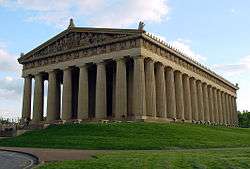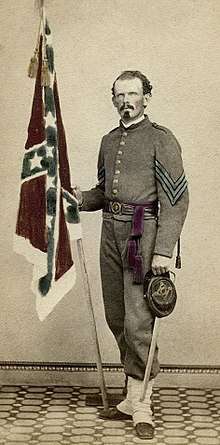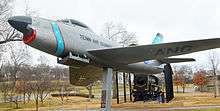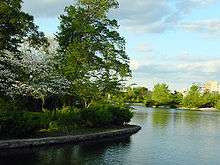Centennial Park (Nashville)
| Centennial Park | |
|---|---|
 The Parthenon is the centerpiece of the park. | |
| Type | Public park |
| Location | Nashville, Tennessee |
| Coordinates | 36°08′56″N 86°48′43″W / 36.149°N 86.812°W |
| Area | 132-acre (0.53 km2) |
| Created | 1903 |
| Operated by | Metropolitan Nashville Department of Parks and Recreation |

Centennial Park is a large urban park located approximately two miles (three km) west of downtown Nashville, Tennessee, across West End Avenue (U.S. Highway 70S) from the campus of Vanderbilt University and adjacent to the current (2016) headquarters campus of the Hospital Corporation of America. It was dedicated as a public park in 1903; however, blacks were banned from the park under Jim Crow-era regulations until the 1960s. It includes the Parthenon and the Confederate Private Monument.
History
The 132-acre (0.53 km2) park was originally farmland that had belonged to John Cockrill and his wife, Anne Robertson Johnson Cockrill (1757–1821), the sister of General James Robertson.[1] She and her family came from Wake County, North Carolina to Fort Nashborough (now Nashville) in the Donelson Flotilla, led by Andrew Jackson's wife Rachel's father, John Donelson.[1] She was the first woman to be given a land grant in Tennessee.[2] Their son Mark R. Cockrill, known as the "Wool King of the World", owned up to 300 slaves prior to the Civil War, although most of them worked on his Mississippi plantation.[3] Cockrill loaned gold and wool to the Confederate States Army during the war, and he was arrested and jailed for his Confederate support.[3]
Some of the land was part of the old Burlington plantation established by Joseph T. Elliston, who served as the fourth mayor of Nashville from 1814 to 1817, and it was later owned by his son, William R. Elliston, a Whig politician.[4] The Ellistons were slaveholders,[5] and their plantation extended into the campus of Vanderbilt University and West End Park.[4] Their mansion, on modern-day Elliston Place, was torn down in the 1930s.[6]
The land was turned into the state fairgrounds after the Civil War. From 1884 to 1895, the site served as a racetrack and was known as West Side Park. In 1897, it was the site of the Tennessee Centennial and International Exposition and was renamed Centennial Park.[7] After the exposition ended, most of the building and exhibits were dismantled, leaving in its place a landscaped open area with a small artificial lake (named "Lake Watauga" after the region, then in western North Carolina, where many of Nashville's early settlers moved from), sunken gardens, and a bandshell. The Parthenon, honoring Nashville's status as "The Athens of the South", was designed by William Crawford Smith,[8] and became the most prominent feature of the park.[7] The park was officially dedicated in May 1903.[7]
The Confederate Private Monument, designed by George Julian Zolnay, was dedicated in 1909.[9]
This area became an important recreation site for white Nashvillians; "Jim Crow" laws forbade its use by African Americans until the 1960s, which resulted in disagreements. For example, on July 18, 1961, six African-Americans were turned away when they tried to use the public swimming pool in the park.[10][11] The next day, all Nashville public pools were closed down under the pretext of "financial reasons".[12] The pool eventually reopened as an arts center.


The Parthenon replica, built largely out of plaster as a temporary exhibit building (the Nashville pavilion of the Centennial Exposition) began to fall into disrepair and was proposed for demolition on several occasions, but public sentiment in favor of this symbol of Nashville as the "Athens of the South" precluded this. Finally, in the 1920s it was agreed to replace the temporary plaster building with a permanent, concrete and steel replacement which remains today and has been refurbished on several occasions.
From 1954 to 1967, the Parthenon was the backdrop for an enormous nativity scene sponsored by the now-defunct Harveys department store. The scene was approximately 280 feet (85 m) long, 75 feet (23 m) deep and was flooded with colorful lights. However, by 1968, it was sold to a Cincinnati shopping center. According to the Nashville Banner, the nativity scene was shown only two Christmas seasons in Cincinnati before it collapsed and was discarded.
The park was the site of Sunday concerts in the 1960s; Pat Boone was one of the early performers.[13] By 1975, the climactic scene in Robert Altman's Nashville was shot in the park.
In 1990, a statue of Pallas Athena designed by Nashville sculptor Alan LeQuire was added to the art gallery inside the parthenon.[14]

There were many mature shade trees in the park until the 1998 Nashville tornado outbreak; most of them were damaged or destroyed in the storm. The park was also the site of the storm's sole fatality, a Vanderbilt ROTC cadet.[15] Since then, the park and other areas of outdoor gathering in the Nashville area have been equipped with storm-warning sirens.
On November 11, 2005, Centennial Park became Nashville's first wireless internet park by offering free Wi-Fi internet access to park patrons.[16] The park's bandshell is also the site of the annual "Shakespeare in the Park" presented by the Nashville Shakespeare Festival from late August to early September.
In 2012, workers found the source of the spring that was a major feature during Anne Robertson Johnson Cockrill's ownership and excavated it. It is a significant feature to the land that had been capped and piped to the sewer for 100 years, piping more than 100 gallons of water per minute.[17][18]
On August 26, 2016, as part of Women's Equality Day, a monument by Alan LeQuire was unveiled in the park, featuring depictions of Carrie Chapman Catt, Anne Dallas Dudley, Abby Crawford Milton, Juno Frankie Pierce, and Sue Shelton White.[19][20]
The park also contains a recreation center and is the home of the administrative offices of the city's Department of Parks and Recreation; however, these are currently in the process of moving to the East Bank of the Cumberland River adjacent to Nissan Stadium in the offices of the former Nashville Bridge Company.
References
- 1 2 Bucy, Carole Stanford. "Ann Robertson Johnston Cockrill". The Tennessee Encyclopedia of History and Culture. Tennessee Historical Society and the University of Tennessee Press. Retrieved August 27, 2016.
- ↑ Stanford Bucy, Carole (December 25, 2009). "Ann Robertson Johnston Cockrill". The City Cemetery. Retrieved April 22, 2017.
- 1 2 Zollicoffer Bond, Octavia (November 28, 1909). "The Cockrill Family". The Tennessean. p. 34. Retrieved April 15, 2018 – via Newspapers.com. (Registration required (help)).
In anticipation of the ruin to Southern interests that his keen vision foresaw, he sold his large Mississippi plantation, to which he was in the habit of going every winter [...]. He also sold the 300 slaves on the plantation with the exception of about sixty selected "hands", whom he brought to Tennessee to watch and care for his sheep.
- 1 2 Davis, Louise (August 14, 1983). "Early Silversmiths Left Marks on City. Names of Elliston, Calhoun Figure Big in Nashville History". The Tennessean. pp. 93–94. Retrieved April 14, 2018 – via Newspapers.com. (Registration required (help)).
- ↑ Epstein Ojalvo, Holly (February 13, 2017). "Beyond Yale: These other university buildings have ties to slavery and white supremacy". USA Today. Retrieved April 7, 2018.
- ↑ Whitsitt Edwards, Amelia (1999). Nashville Interiors, 1866 to 1922. Charleston, South Carolina: Arcadia Publishing. pp. 27–32. ISBN 9780738502205. OCLC 44274945.
- 1 2 3 Coleman, Christopher K. (Fall 1990). "From Monument to Museum: The Role of the Parthenon in the Culture of the New South". Tennessee Historical Quarterly. 49 (3): 140. JSTOR 42626877. (Registration required (help)).
In May of 1903, Centennial Park was officially opened to the public.
- ↑ "Counting Up The Cost. Executive Committee Considers Plans For Buildings. Several Architects Explain Their Pictures and Discuss Possible Changes, Cost of the Buildings and Other Matters of Interest -- Hearing to be Resumed To-Day". The Nashville American. Nashville, Tennessee. November 19, 1895. p. 5. Retrieved November 23, 2015 – via Newspapers.com.

- ↑ "Confederate Private Monument, (sculpture)". The Smithsonian Institution. Retrieved September 6, 2017.
- ↑ "Negroes Seek Admittance To Swimming Pools". The Kingsport Times. Kingsport, Tennessee. July 19, 1961. p. 6. Retrieved April 22, 2017 – via Newspapers.com. (Registration required (help)).
Jack Spore, city recreation director, said attendants at Centennial Park Pool refused to sell the Negroes tickets and the group left quietly.
- ↑ "Public Pressure Expected To Open Swimming Pools". The Kingsport Times. Kingsport, Tennessee. July 21, 1961. p. 10. Retrieved April 22, 2017 – via Newspapers.com. (Registration required (help)).
On Tuesday, six negroes were denied admission to a Centennial Park pool reserved for white persons.
- ↑ Houston, Benjamin (2012). The Nashville Way: Racial Etiquette and the Struggle for Social Justice in a Southern City. Athens, Georgia: University of Georgia Press. p. 127. ISBN 9780820343266. OCLC 940632744.
- ↑ Evans, Jim (July 16, 1964). "'Music City' Tour Set Up". The Kingsport Times. Kingsport, Tennessee. p. 11. Retrieved April 22, 2017 – via Newspapers.com. (Registration required (help)).
The folks are shown where Pat Boone attended school and told how Pat got his start with the Sunday concerts in Centennial Park.
- ↑ Bliss, Jessica (August 24, 2016). "Alan LeQuire's Women Suffrage Monument unveiled in Nashville's Centennial Park". The Tennessean. Retrieved April 22, 2017.
LeQuire has created numerous public commissions in his 35 year career. At age 26, he began Athena Parthenos, the looming sculpture inside the Parthenon at Centennial Park. It took eight years to complete and was unveiled in 1990.
- ↑ Ian Demsky. "Tornado sirens go unheard in many areas". The Tennessean, June 9, 2004.
- ↑ "Centennial adds wireless service". The City Paper. November 10, 2005. Retrieved April 22, 2017.
- ↑ Ferrier, Dennis. "Underground spring to help transform Centennial Park". Retrieved 2015-05-06. The stream was subsequently daylighted.
- ↑ http://www.cleanwaternashville.org/content/updates/cockrill-springs-is-new-feature-of-centennial-park
- ↑ 5:33 PM, Aug 26, 2016. "Women's Suffrage Monument Unveiled - Story". Newschannel5.com. Retrieved 2016-08-27.
- ↑ "Nashville's Newest Monument Celebrates State's Role In Women's Winning The Right To Vote". Nashville Public Radio. Retrieved 2016-08-27.
Further reading
- Johnson, Leland R. (1986). The Parks of Nashville: A History of the Board of Parks and Recreation. Nashville: Metropolitan Nashville Board of Parks and Recreation.
External links
- Tennessee Centennial Exposition, Tennessee Virtual Archive, Tennessee State Library and Archives.
- Tennessee Centennial and International Exposition (1879) Collection, 1895-1900, Tennessee State Library and Archives.